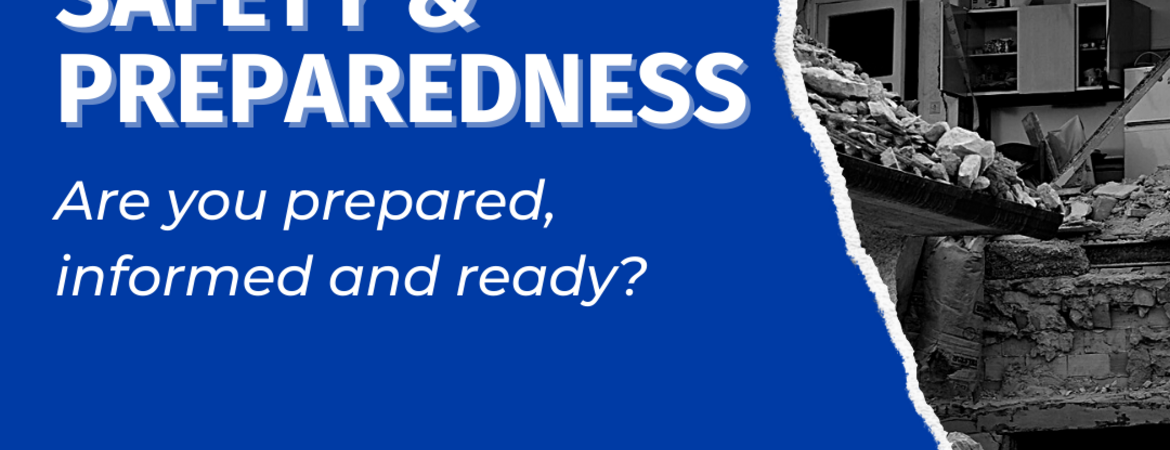
Did you know that FEMA Ranks Riverside County Among Riskiest in U.S. For Natural Disasters?
Southern California is known as “earthquake country.” The recent 7.5 magnitude earthquake that stuck in Türkiye this week, causing damage, destruction and death across 5 countries in the region, is a humble reminder of the power of nature. As our hearts go out to the people in the affected regions, now is the time to also pause and reflect on how we are preparing for an earthquake at UCR and at home. We are profoundly saddened by the devastating earthquakes in Türkiye and Syria. We offer our sincere condolences and solidarity to all those affected.
What can you do?
Start with being prepared. There are a host of resources for Californians to prepare for an earthquake, as well as Campus resources for emergencies.
- Know your evacuation route at UCR. Learn where your Emergency Assembly Area is located.
- Prepare an emergency kit for your home: include food, water, medication, contact numbers, clothing, electronics and more. View a Checklist for an Emergency Kit
Learn what to do during an earthquake:
If you are indoors: Stay indoors!
- DROP, COVER and HOLD ON! Drop to the ground; take cover by getting under a sturdy table, bench or desk and hold on. If there isn’t a table or desk near you, cover your face and head with your arms and crouch down into a ball next to an interior wall. * Move away from windows that may break and furniture or large objects that could fall over.
- Be aware that the electricity may go out and fire alarms and sprinkler systems may activate.
- If you are in bed stay there! Hold on and put a pillow over your head for protection.
- If you are in a theater or stadium, stay in your seat or get under it if possible, and protect your head with your arms. Do not try to leave until the shaking is over.
- If you are in a crowded room or public place, do not rush for exits. Move away from display shelves holding objects that could fall on you and “drop, cover and hold.”
- Do not use elevators.
If you are outdoors: Stay outdoors!
- Move to an open area away from trees, buildings, utility poles and lines, or signs.
- If you are in a downtown area, on a sidewalk near a tall building, get inside the building’s lobby to protect yourself from falling bricks, glass or other debris.
- Greatest danger exists directly outside buildings at exits and alongside exterior walls.
If you are driving:
- Pull to the side of the road as quickly as possible, but keep away from overhead hazards such as trees, buildings, utility poles and lines, signs, and bridges. Stay in the vehicle until the shaking stops.
Know what to expect after an earthquake:
- Check yourself and those around you for injuries.
- Evaluate for yourself, or wait for instructions from your Building Safety Emergency Coordinator (BSEC), to determine if evacuation is necessary.
- If the building seems largely unscathed, stay where you are.
- If there are noticeable cracks in the wall, windows are broken, or you can smell natural gas (rotten eggs), then proceed with evacuation protocols.
- If you need to evacuate, collect all personal belongings to take with you. Look for signs of building damage or for persons who are injured or trapped, on your way out. Watch for falling objects as you leave the building.
- Be prepared for aftershocks.
- Go to your department Evacuation Assembly Area, tell your supervisor or department floor warden that you are out of the building and report injured or trapped persons and any signs of building damage you observed.
- Turn on a battery-powered or vehicle radio if available for information.
- If possible, do not use the phone for local calls, except emergencies, during the first 15-30 minutes after the earthquake. Overloading the phone system with calls may delay the delivery of emergency assistance.
- WHEN TO GO HOME:
- In the event of a major earthquake, be prepared to stay on campus. You should not try and get home until emergency personnel say it is safe, the streets are cleared for travel, and most emergency conditions have been stabilized. The campus is prepared to provide emergency care and shelter in partnership with the American Red Cross.
An earthquake can happen at any time. Being prepared (at Campus and at home), knowing what to do during an earthquake, and knowing what to expect after one is the best way to protect yourself and others during a seismic event. Practicing for an event is also key. Please consider participating in your building Fire and evacuation drills, and joining the Great California Shakeout’s statewide earthquake drill on October 19, 2023.
If you are interested in joining the Building Safety Emergency program (known as BSEC/BES) please contact the Office of Emergency Management: emergency@ucr.edu.
Stay safe highlanders!
Additional Earthquake & Emergency Preparedness Resources:
- UCR Emergency Management: https://emergency.ucr.edu/emergency-preparedness
- Earthquake Warning California: https://earthquake.ca.gov/
- Fire & Life Safety (UCR Fire and Evacuation Drills) https://fire.ucr.edu/
- UCR Geology Department: https://epsci.ucr.edu/research/earthquakes-geophysics
- Cal-OES: https://www.caloes.ca.gov/
- FEMA Earthquake Safety Checklist
- Ready.gov: Prepare Before an Earthquake: https://www.ready.gov/earthquakes
- California Earthquake Authority (CEA) https://www.earthquakeauthority.com/
- Southern California Earthquake Center: https://www.scec.org/
- Riverside County Emergency Services: https://rivco.org/services/public-safety/emergency-services